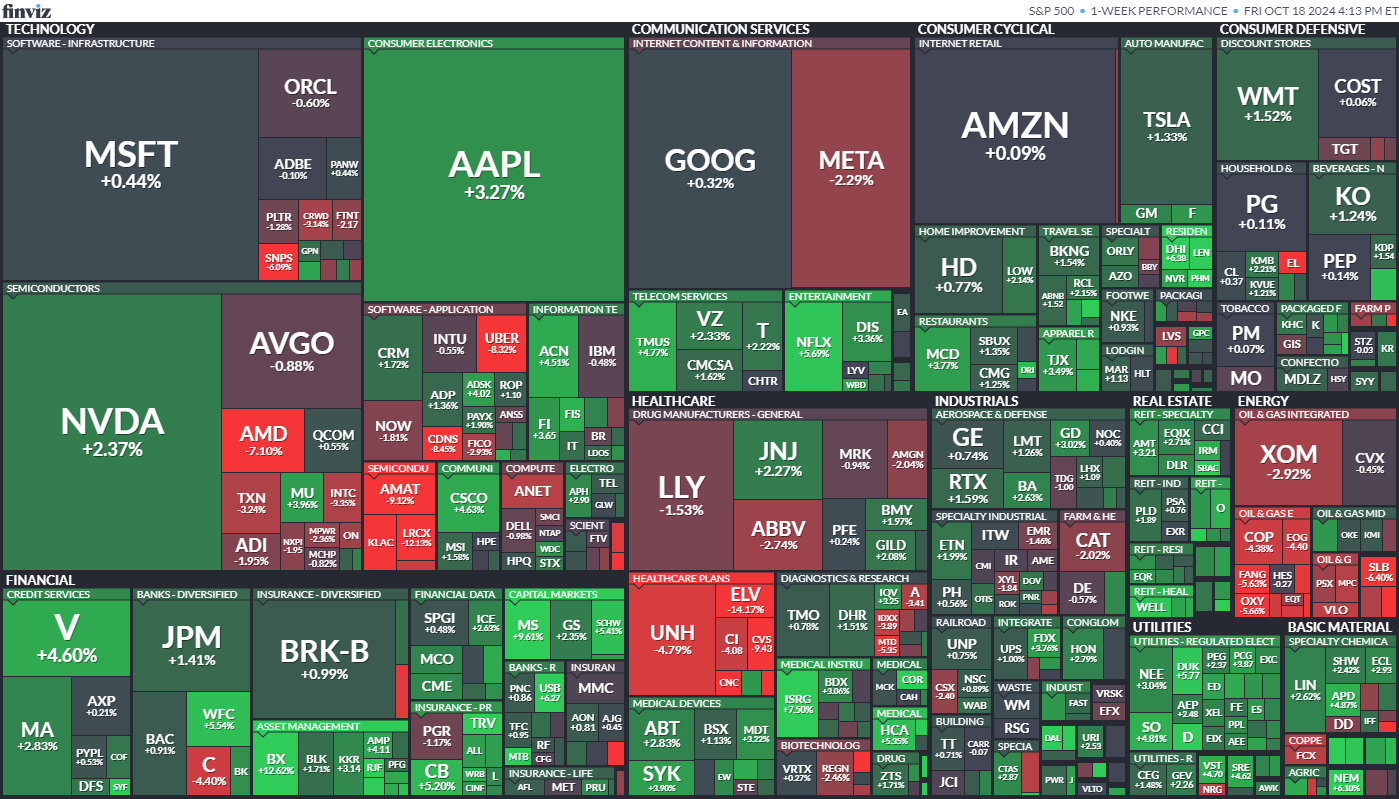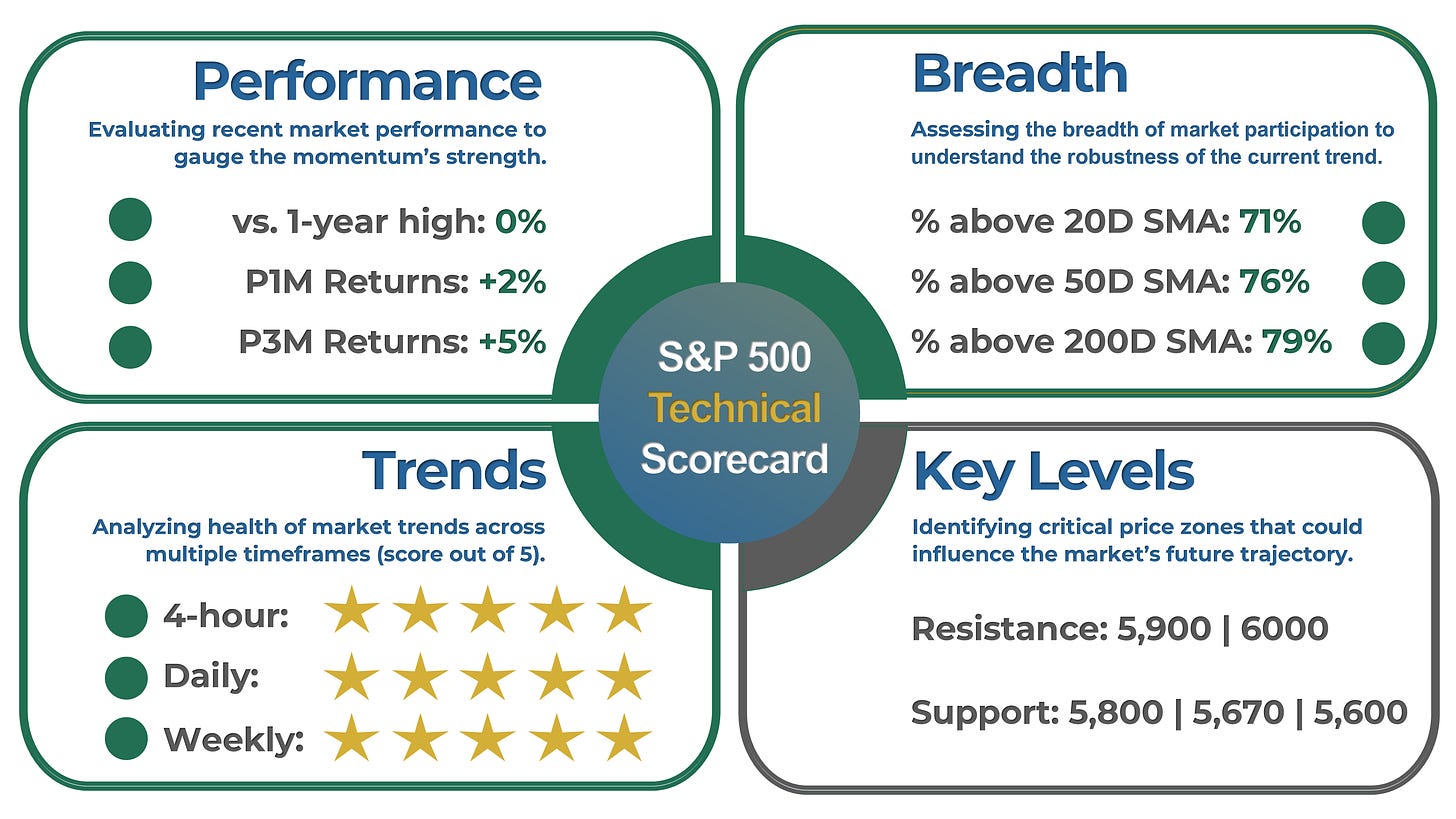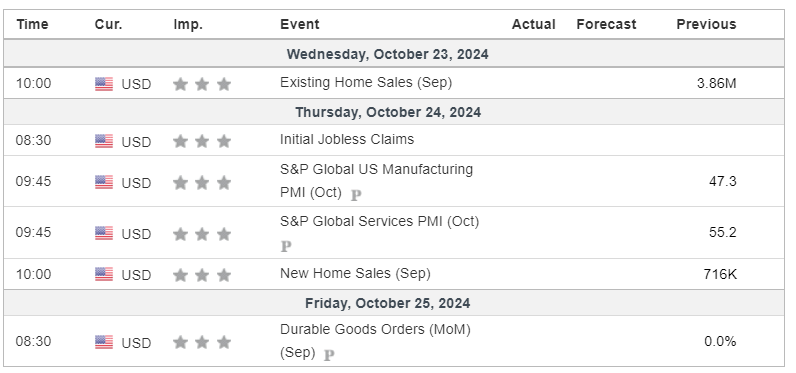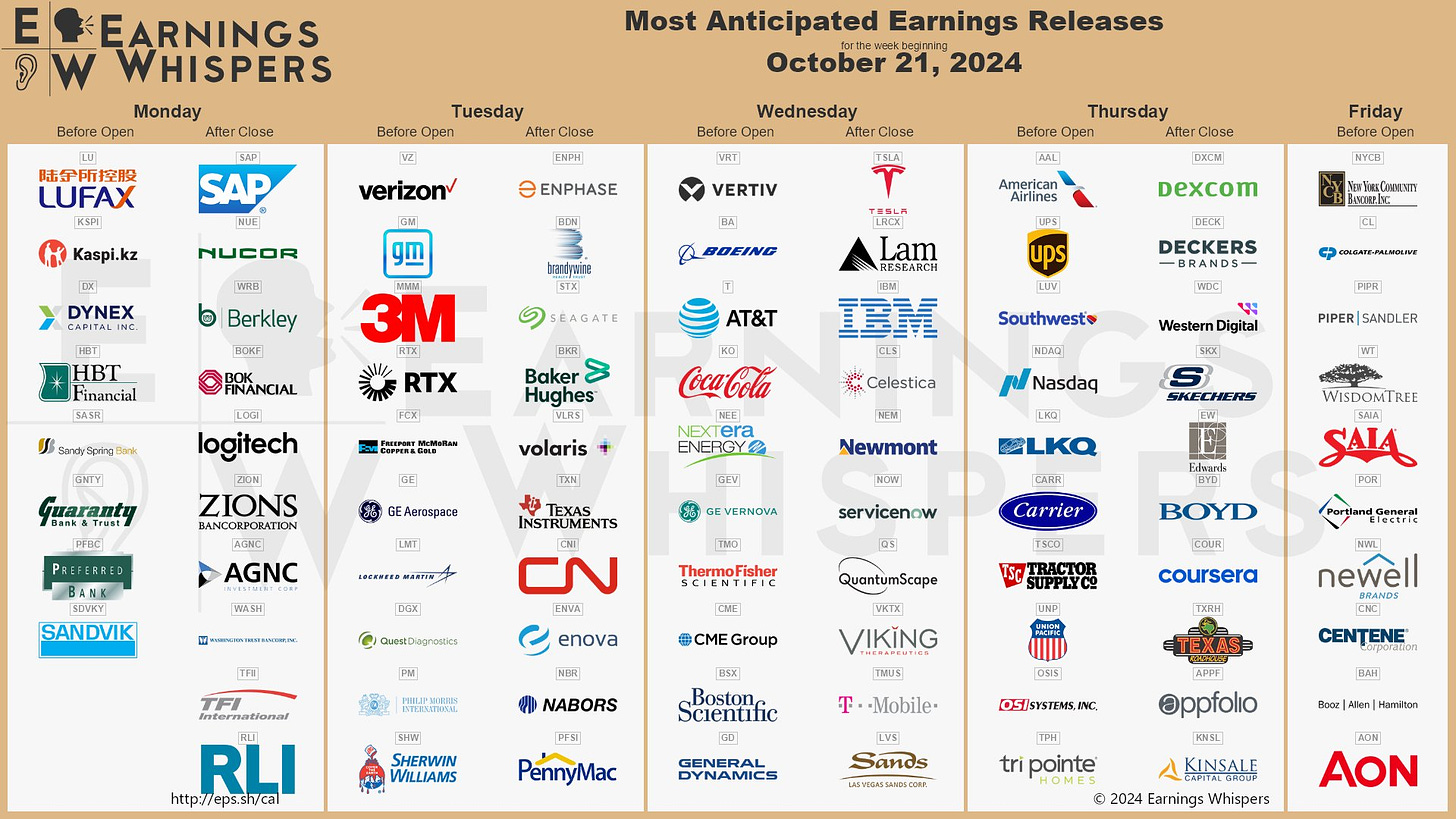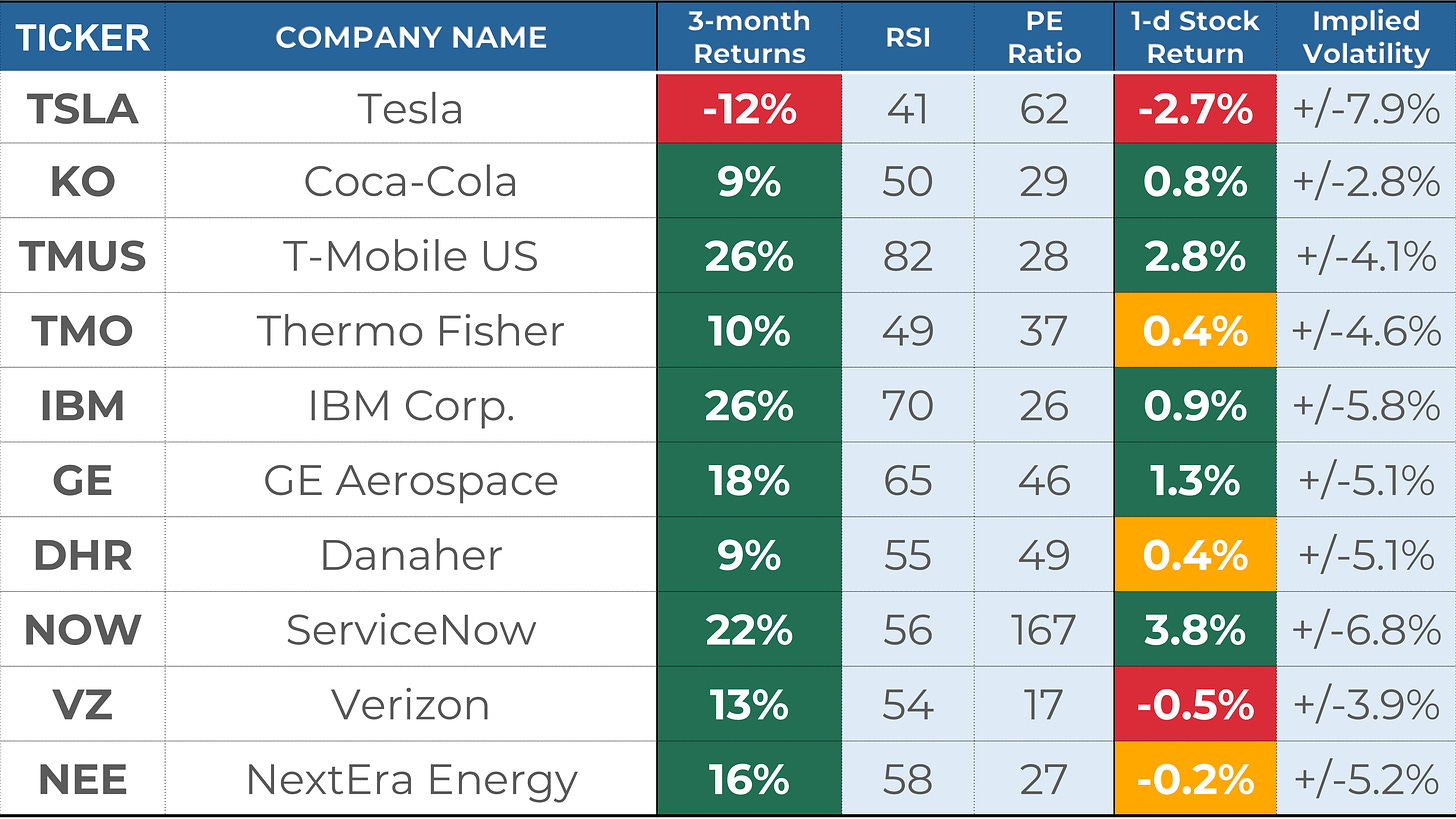Weekly Market Recap (Oct 14-18): Another New High But Can the S&P 500 Push to 6,000 by Year-End?
Everything you need to know about last week's markets performance and what to expect next.
Dear subscribers,
Welcome to My Weekly Stock, where we blend in-depth market analysis with proven momentum-based trading strategies. My mission? Help you navigate the financial markets with unbiased, data-driven insights you can act on!
Every week, I spend hours curating this market recap, producing insightful analyses with clear visuals and a structured layout so you can easily find what you need, week after week. And because it's easy to get swayed by personal bias, I like to let the data do most of the talking.
Remember to upgrade your subscription to access all my trading and investing portfolios, and see how I protect my gains in these turbulent times!
Let’s get started!
SUMMARY
Here are this week's highlights and what to look out for next:
1. The markets were positive this week, with the S&P 500 up 0.9%, the Nasdaq 0.8%, and the Dow Jones 1%. Utilities (+3.4%) and Real Estate (+3%) were the best-performing sectors.
2. The S&P 500's long-term trend is positive, and so is the short-term momentum. 5,900 is the next resistance, while 5,800 is support.
3. The Q3 earnings season is picking up steam and 71 companies from the S&P 500 index have released their Q3 results, with 83% beating estimates. Earnings are expected to be up 4% in Q3 2024 and 9% in 2024.
4. Market sentiment is at the "Greed" level (74) as measured by CNN’s Fear & Greed indicator, while VIX is at a medium value of 18.
5. Earnings reports from Tesla and Coca-Cola, as well as the PMI index are scheduled for next week.
My take:
As per the common pattern lately, we saw an early-week shakeout, this time on Tuesday. And once again, there was no follow-through, and the market quickly recovered, closing the week with yet another high.
While the short- and long-term trend is largely positive, some indicators are nearing overheating levels. Just last week, 30% of the S&P 500 components hit new 1-year highs—the largest number this year. It suggests that some consolidation may be warranted soon. However, as long as pullbacks remain mild and quickly bought, the bulls remain firmly in control and 6,000 will likely act as a strong magnet for the S&P 500.
PERFORMANCE RECAP
1. S&P 500 Sector Performance
Over the week, 9 of the 11 S&P 500 sectors have achieved gains. Utilities led the way, rising by 3.4%. By contrast, Energy was the weakest, falling by -2.6%.
Year-to-date, all the sectors have seen positive results. Utilities has been the most successful sector, with a 29% gain. On the other hand, Energy has been trailing behind.
2. S&P 500 Top & Worst Performers
In the last 5 trading days, 71% of the stocks in the S&P 500 index rose in value.
The best-performing stocks were:
United Airlines Holdings Inc (UAL, 20%)
Walgreens Boots Alliance Inc (WBA, 17%)
Blackstone Inc (BX, 13%)
Meanwhile, the worst-performing stocks were:
Molina Healthcare Inc (MOH, -12%)
Elevance Health Inc (ELV, -14%)
Centene Corp. (CNC, -14%)
In addition, 147 stocks within the S&P 500 reached a new 52-week high, while 4 set new lows. Most of the highs this week came from the Financial sector.
MARKET TRENDS & MOMENTUM
1. S&P 500 Long-Term Trend
The long-term trend for the S&P 500 is positive. I base this evaluation on the 9 and 30-week exponential moving averages (EMAs). To determine if the trend is strongly positive, I look for the following conditions (the 1st is the most important):
9-week EMA is above the 30-week EMA: 🟢
Price is trading above the 9-week EMA: 🟢
Price is trading above the 30-week EMA: 🟢
The 9-week EMA trend line is rising: 🟢
The 30-week EMA trend line is rising: 🟢
I also use the MACD as an additional tool to detect trend changes. The MACD line has crossed its signal line, a positive indication for the index.
2. S&P 500 Technical Analysis
Healthy bull markets typically see the index set several new highs, broad market participation, and ascending trend lines. That's why I've created a four-part scorecard – a straightforward tool to give us a comprehensive view of these essential health indicators.
Momentum: The index is up 2% over the past month, 5% in the last three months, and is trading less than 1% away from its 52-week high.
Breadth: Market participation remains healthy in the long term, as 79% of S&P 500 stocks are trading above their 200-day moving average (SMA). Meanwhile, 71% of the stocks are trading above their 20-day SMA, up from 62% the previous week. A reading above 80% or below 20% typically indicates an overextended trend.
Trends: The trend on the 1-day and 4-hour charts is positive, with the index trading above its 21-period exponential moving average.
Key levels: The next resistance level is 5,900. On the other hand, the next support areas are at 5,800.
3. Momentum Analysis of the Week
This week's momentum analysis is about market segments' trends. Using a combination of performance metrics and technical indicators, I've developed a proprietary algorithm to rank these various segments of the market and identify potential outperformers. Based on this approach, I've identified the Gold and stock indices as having the best relative momentum currently.
EARNINGS RECAP
1. Q3 and Full Year 2024 Expected EPS & Revenue Growth
Q3 2024 earnings for the S&P 500 are expected to be up 4%. Excluding the energy sector, the figure is +6%.
Earnings are projected to grow by 9% in 2024, in line with the 9% growth seen on average over the last decade. In the past four weeks, 46% of earnings revisions made by analysts were to increase their outlook.
The forward 4-quarter P/E ratio is 22.0, higher than the average over the past five and ten years.
2. Q3 Earnings Season Summary
71 companies from the S&P 500 index have released their third-quarter earnings, with 83% posting higher EPS than expectations. This is higher than the previous four-quarter average of 79% and higher than the historical average of 67%.
MARKET SENTIMENT
Measures of investor sentiment can be helpful as they provide insight into the views and opinions of professional or individual investors. However, it's important to note that these measures are not perfect predictors of market movements. They should be combined with other indicators and analysis tools for a complete market picture.
1. AAII Sentiment Survey (Individual Investors)
The American Association of Individual Investors (AAII) conducts a weekly survey among its members to gauge their expectations for the stock market over the next six months. The results are published every Wednesday.
According to the most recent AAII survey, 46% of the respondents had a bullish outlook on the stock market, decreasing by 3 points from the previous week.
2. BofA Bull & Bear Indicator (Institutional Investors)
The Bank of America Bull-Bear Indicator is a proprietary measure of investor sentiment developed by Bank of America. It is based on a survey of fund managers and institutional investors, and it tracks the percentage of respondents who are bullish, bearish, or neutral on the stock market. Results are published in the form of a score ranging from 0 (extremely bearish) to 10 (extremely bullish)
The latest reading available of the indicator was 7.1, a bullish sentiment reading.
3. CNN Fear & Greed Index (Technical)
The CNN Fear & Greed Index is a daily measure that analyzes seven market indicators to assess how emotions influence investors' decisions. The index is scored out of 100 and categorizes results into five stages: Extreme Fear, Fear, Neutral, Greed, and Extreme Greed.
The index closed at 74, or a “Greed” level, in line with last Friday.
THE WEEK AHEAD
1. Economic Calendar
Next week will be light on the economic data front. On the agenda on Thursday is the Purchasing Managers' Index (PMI). This index indicates the health of the manufacturing and service sectors, directly reflecting economic outlook sentiments from purchasing managers.
2. Earnings Calendar
Earnings season continues next week, and 114 companies from the S&P 500, including Tesla and Coca-Cola, are expected to release their quarterly results.
3. Next Week’s Earnings Watchlist
Below is my watchlist of stocks reporting week next week, along with several key indicators I like to review:
Stock Indicators:
Stock performance in the last 3 months.
RSI, where a reading of 70 indicates overbought status and a reading of 30 oversold.
PE ratio, where a reading below 25 indicates a "cheap" valuation and/or low growth expectations.
Stock Price Reactions to Earnings:
1-day Stock Return on Earnings is the stock performance on the earnings release date.
Implied volatility is the expected 1-day stock change after earnings are released, as assessed by the options markets.
Every week, I share my analysis of 1 stock reporting earnings in the coming days, focusing on implications for long-term investors. This week, I prepared an in-depth overview of Tesla ($TSLA). In this post, I break down key data points around Tesla’s fundamentals, stock returns, analyst ratings, and past earnings performance to help you make informed investment decisions. Check out the post and learn why I gave a “PASS” rating to Tesla.
That’s a wrap for this week’s recap! I hope it helped you understand the market better.
If you enjoyed this post, you should explore the premium section: I provide my short-term trading and analysis of over 20 US large caps and share my long-term investing portfolios. Upgrade your subscription to unlock all the exclusive features and insights.
If you have any questions or feedback, please don't hesitate to email me or comment on this post. Your support helps me create high-quality content and is greatly appreciated!
Have a great week!
My Weekly Stock
DISCLAIMER
The information provided in this newsletter is for informational purposes only and should not be taken as financial advice. Any investments or decisions made based on the information provided in this newsletter are the reader's sole responsibility. We recommend that readers conduct their own research and consult a qualified financial professional before making investment decisions. The author does not assume any responsibility for any losses or damages arising from using the information provided in this newsletter.




